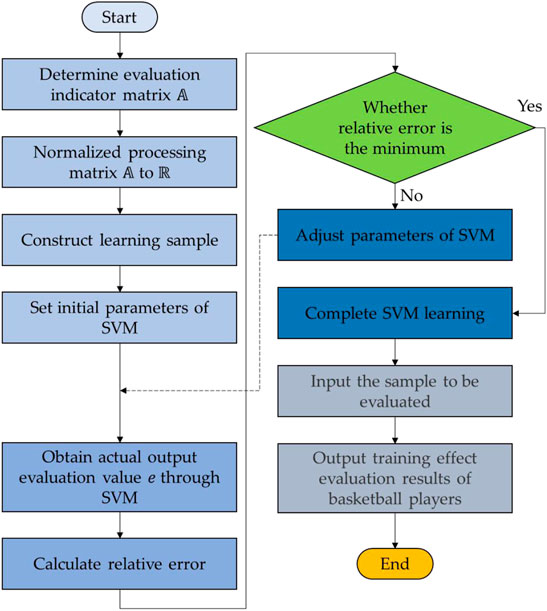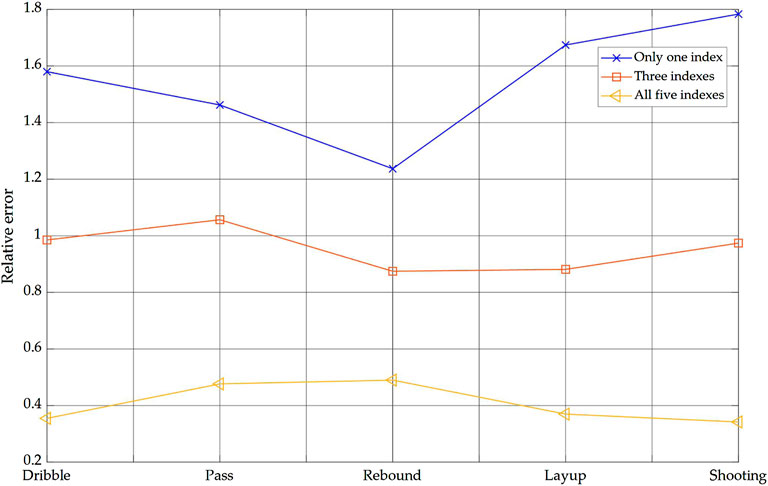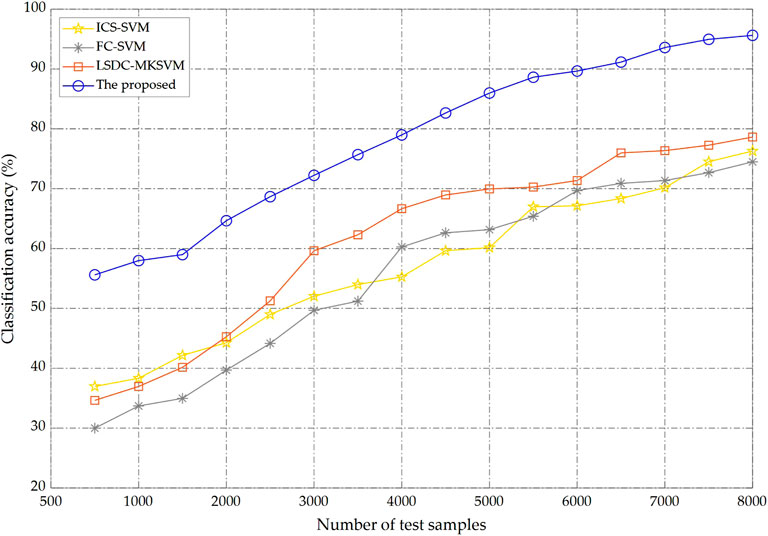- 1Shangqiu University, Shangqiu, China
- 2Shandong Sport University, Jinan, China
To reduce errors in the evaluation of basketball players’ training effect and facilitate the coaches to make reasonable training plans, this study proposes an evaluation method of the basketball player training effect based on wearable devices and machine learning algorithms. Wearable devices in social physics are intelligent, and their main components are integrated into clothing and other accessories. They collect data, track activities, and customize the experience to the needs and desires of users. In this study, physiological indicators such as heart rate and hemoglobin are selected as input vectors of the support vector machine (SVM), and the expected value of basketball player training effect evaluation is taken as the output to construct training samples. The parameters of the SVM are set to minimize the evaluation error as the learning objective. The SVM learns training samples and constructs an evaluation model for the training effect of basketball players. We use the method proposed in this study to evaluate the training effect of basketball players through computer simulation of dribble, pass, rebound, layup, and shooting. The experimental results show that the training effect evaluation of basketball players with the proposed method has a low relative error, high classification accuracy, and high practical application value.
1 Introduction
As a comprehensive and strong sports event, basketball has a high requirement on the coordination, flexibility, stability, and explosive force of the players and requires high-strength training to achieve the abovementioned skills and levels [1, 2]. However, traditional basketball training cannot meet the requirements of basketball players in the new era, and especially in the basic physical quality training of athletes, there are many shortcomings [3–5]. In recent years, basketball teaching and training based on wearable devices have been gradually introduced into the basketball training system. Relevant research shows that after the introduction of basketball teaching and training based on wearable devices, the shooting accuracy is significantly higher than that of traditional training [6]. Therefore, it is of great significance to apply basketball teaching and training based on wearable devices.
Against the backdrop of science and technology, sports training is also developing new ideas, new technology, new equipment, and other aspects [7]. Wearable devices based on mobile Internet and a cloud platform with functions of wireless transmission and fast real-time feedback are increasingly, widely, and deeply used in sports training, providing a more convenient and scientific way to explore the biological significance of sports training [8–10]. Due to the needs of competitive sports, athletes should complete physical activities under extreme conditions such as high speed and high confrontation, and any external factors may interfere with their normal performance. Therefore, wearable devices must collect data without affecting their normal performance, and integration of sensor functions and miniaturization of appearance are particularly important [11, 12].
Daily training of athletes is an important way to improve their performance in competitions. Daily training of athletes helps coaches to clarify the status and competitive level of athletes [13]. Training programs are formulated according to the training situation of athletes, and accurate evaluation of training effects is an important part of improving the performance of athletes. The evaluation is affected by many factors such as athlete psychological state and training environment, which is mainly divided into linear evaluation and nonlinear evaluation. The evaluation of the athlete training effect is characterized by nonlinear variation [14]. The linear evaluation method cannot guarantee the accuracy of training effect evaluation, while the nonlinear evaluation method can fully consider the impact factors of athlete training and has become the main research direction in the evaluation field. Machine learning (ML) is an efficient algorithm among nonlinear evaluation methods, among which the support vector machine (SVM) has a good evaluation effect [15, 16]. The kernel function and parameters of the SVM can effectively improve the evaluation accuracy of the athlete training effect. In view of the instability and randomness of athlete training effect evaluation, it is of great practical significance to study efficient evaluation methods.
Applying physiological-state indexes to the evaluation of an athlete’s training effect can improve the scientific nature of the athlete’s training process [17]. The physical function state of athletes determines the performance of the physical function of athletes. We can ascertain the physical state of athletes through wearable sensors, and it is scientific to evaluate the training effect of athletes based on the physical function state of athletes. The training tasks of athletes are adjusted through the physical state of athletes, and the whole training process is formulated scientifically. The SVM method of the ML algorithm is applied to evaluate the training effect of basketball players, which is helpful in analyzing the training effect of basketball players and improvoing the performance of basketball players through scientific and reasonable training plans.
The main contribution of this study is that an evaluation method of the training effect of basketball players based on wearable devices and the ML algorithm is proposed. The rest of the study is organized as follows: Section 2 summarizes the related works; Section 3 proposes the evaluation method of the training effect of basketball players based on wearable devices and the SVM; experimental results are reported in Section 4; finally, section 5 concludes this study.
2 Related Works
Powered by advanced computer technology, the appearance and performance of wearable devices are changing more and more rapidly. Devices including GPS, accelerometer, gyroscopes, and so on have collected a large amount of original data, which increasingly relies on methods such as the support vector machine (SVM), k-means, and deep neural network (DNN) to deep mine and process the data [18]. Data mining technology can make a clear processing and display of the correlation of various factors between various data, thus discovering some sports laws of great value, achieving effective control over the process of sports training and constantly promoting wide and profound changes in competitive sports. By combining the extraction and processing methods of the abovementioned basic data of sports training, we can conclude that the accuracy and calculation methods of data operation in various sports modes may become the core elements of the future development of wearable devices. In [19], the authors combined the basic knowledge of human body posture measurement and human body model to build a parametric and variable human body posture model. Using wireless wearable devices, in [20], the authors studied the physical quality, psychological state, and training environment of the athletes and constructed the indicators for monitoring their development in routine training. In [21], the authors designed a wearable device that used acceleration sensors to obtain the acceleration information generated by the user’s muscles in the process of movement. In [22], the authors provided a comprehensive overview of the application of wearable technology in evaluating biomechanical and physiological parameters of athletes. In [23], the authors designed a wearable device that accurately calculated and monitored energy consumption for exercise.
ML is a new data processing method with the rapid development of computer technology, which can ensure that computers can have the same learning ability as human beings, and it also provides technical support for effectively processing large-scale data. As a typical intelligent classification model, the SVM has excellent classification ability and has been widely used in data classification. In [24], the authors proposed an SVM kernel function that could classify data without spatial transformation. In [25], the authors proposed an unbalanced data classification algorithm based on clustering and SVM. In [26], the authors proposed an improved cost-sensitive SVM (ICS-SVM) algorithm to solve the imbalance problem in network traffic recognition. In [27], the authors proposed a fast classification method of the SVM (FC-SVM) based on data reconstruction. Marking a sufficient number of training samples is time-consuming and laborious; as for this, in [28], the authors proposed a large-scale data classification strategy and then used the selected instances to train a multi-kernel SVM to obtain the classifier model to predict the subsequent new instances (LSDC-MKSVM).
3 Machine learning–Based Training Effect Evaluation of Basketball Players
3.1 The Machine Learning–Based Algorithm
Let
where the probability measure
where
The SVM has a high promotion level [30, 31], which seeks the final results of models with the best learning ability and low complexity based on limited sample information. It is suitable for high-dimension, small sample, and nonlinear data space, and its generalization level is high. Selecting the SVM as the evaluation method of the training effect of basketball players can make full use of the advantages of the SVM in data processing of small samples and obtain the best classification surface [32] through a small number of samples. The obtained classification surface evaluates the training effect of basketball players who pay the lowest price and has the highest popularization.
Training data are represented by
where
where
The SVM method is used to search the hyperplane with maximum interval.
subject to
The optimal classification surface problem is transformed into its duality problem by the Lagrange optimization method, which is defined as follows:
Taking
The final optimal classification function is defined as follows:
where
When the experimental sample is linearly indivisible, the relaxation term
subject to
When the penalty term
When the evaluation is a nonlinear problem, the input feature x is transformed into the high-dimensional feature space according to the constructed nonlinear mapping, and the optimal classification hyperplane [34] is constructed from the high-dimensional feature space of the mapping.
The kernel function
In this case, the optimal classification function is defined as follows:
Different types of nonlinear decision surface SVMs can be realized by different kernel functions [36], and RBF is selected as the kernel function of training effect evaluation of basketball players, which is defined as follows.
3.2 Training Effect Evaluation of Basketball Players
The physiological information generated by basketball players during training can reflect the training effect and show more information that cannot be evaluated by the previous evaluation system of the training effect of basketball players.
The input of training effect evaluation of basketball players is the measured value vector
The basketball player training effect sample
where
Given the aforementioned values, the nonlinear mapping
Applying the SVM of ML to evaluate the training effect of basketball players is shown in Figure 1.
1) According to the physiological indicators that affect the training effect of basketball players, the evaluation indicator matrix
2) The indicator matrix
3) The basketball player training effect sample
4) RBF is selected as the kernel function of the SVM to obtain the regression function.
5) After obtaining the ideal parameters, the learning process of the SVM [39] is completed, and the training effect of basketball players is evaluated by the trained SVM. The physiological test index vector
4 Experiments
4.1 Setup
We use the method proposed in this study to evaluate the training effect of 10 basketball players through computer simulation of dribble, pass, rebound, layup, and shooting. A total of 10,000 experimental samples are collected, including 2000 as learning samples and the remaining 8,000 as test samples. The radial basis function (RBF) is selected as the kernel function of the SVM, and winSVM software is used to solve the SVM. winSVM can adapt to the Windows operating system well and quickly realize the SVM classification and regression problems [40]. The learning samples are divided into 10 groups with 200 in each group. The final parameters are used to train the SVM, and the number of support vectors and parameter b of the regression function is obtained as 40 and -0.226, respectively.
4.2 Result Analysis
Data collected by wearable devices are based on the HealthData.gov dataset. The heart rate, blood oxygen, hemoglobin, creatine kinase, and blood lactate are selected as physiological test indexes to evaluate the training effect of athletes. Statistically, when only the heart rate is used as a single physiological test metric, the heart rate, blood oxygen, and hemoglobin are used as three physiological test indexes, and all five physiological test indexes are used; the relative error of training effect evaluation of basketball players is shown in Figure 2. As can be seen from the experimental results in Figure 2, with the increasing number of physiological test indexes, the relative error of the evaluation results of basketball player training effects has been reduced, indicating that adding more physiological indexes to the ML algorithm can effectively improve the accuracy of the evaluation of the training effects of basketball players . The main reason is that multiple physiological indicators can improve the diversified effect of basketball player training effect evaluation and improve the accuracy of basketball player training effect evaluation.
The output results of evaluating the training effects of five sports for ten athletes using the method proposed in this study are shown in Figures 3A–D. The expert evaluation value is selected as the judgment index of the accuracy of basketball player training effect evaluation. The methods proposed in this study, ICS-SVM [26], FC-SVM [27], and LSDC-MKSVM [28], are used to evaluate the performance of basketball athletes in dribble, pass, rebound, layup, and shooting basketball movements. It can be seen from Figures 3A–D that the method proposed in this study has good training effects in all sports training of basketball players, and ICS-SVM has good performance in pass and rebound, while LSDC-MKSVM has high training effects in the rebound, layup, and shooting.
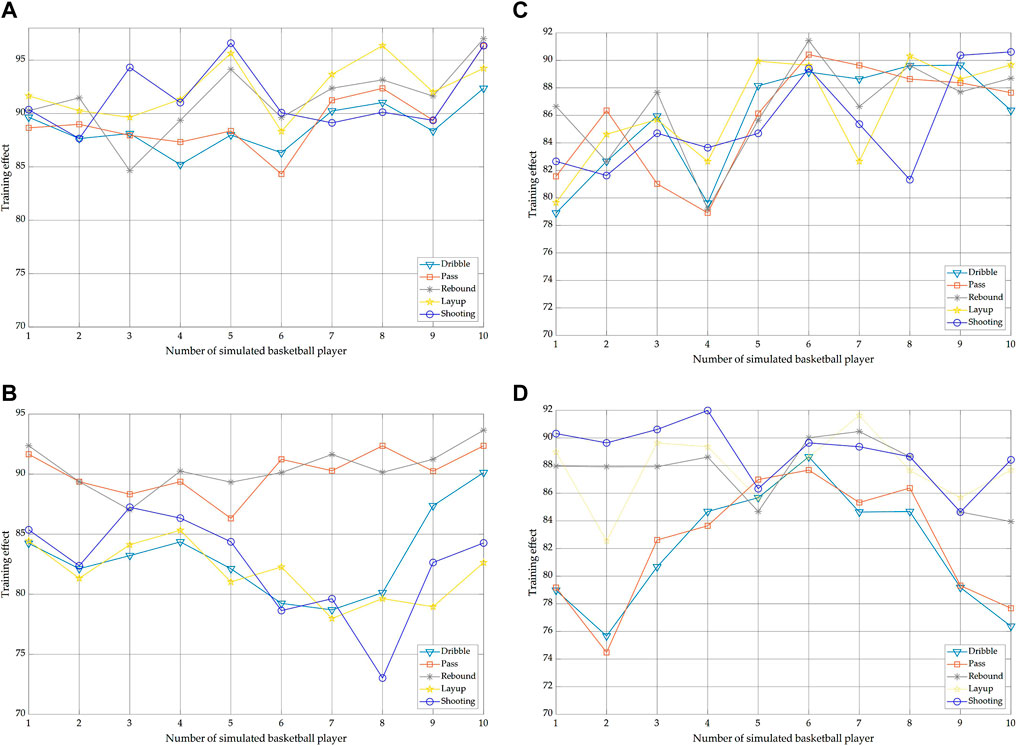
FIGURE 3. (A) Evaluation of teaching and training effect of basketball players under the proposed method. (B) Evaluation of teaching and training effect of basketball players under ICS-SVM. (C) Evaluation of teaching and training effect of basketball players under FC-SVM. (D) Evaluation of teaching and training effect of basketball players under LSDC-MKSVM.
To intuitively show the training effect evaluation performance of the proposed method, the comparative results of the relative errors of the five sports training effects of basketball players evaluated by different methods are shown in Figures 4A–E. From the comparison results in Figures 4A–E, it can be seen that when expert evaluation values are selected as the evaluation basis for performance judgment, the relative errors of the method proposed in this study for evaluating the training effects of various sports of basketball players are all less than 1%. ICS-SVM, FC-SVM, and LSDC-MKSVM are all above 1% relative errors in evaluating the training effects of various movements for basketball players. The comparison results show that the method proposed in this study has higher performance in evaluating the training effect of basketball players. The analysis of the results of the proposed method is helpful for coaches in making training plans for the training effect of basketball players, and the method can be applied to the actual evaluation of the training effect of basketball players.
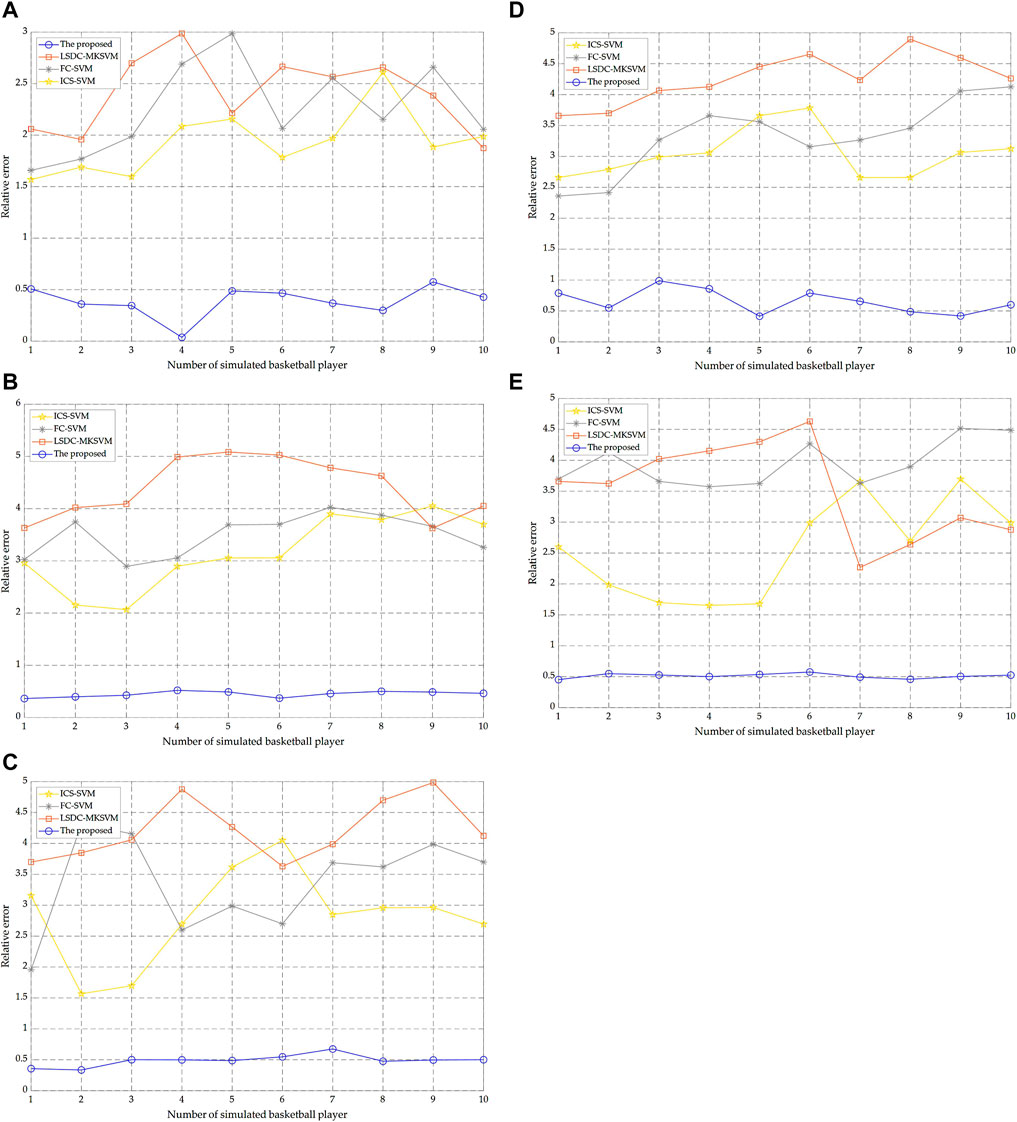
FIGURE 4. (A) Relative error of training effect evaluation with dribble. (B) Relative error of training effect evaluation with pass (C) Relative error of training effect evaluation with rebound (D) Relative error of training effect evaluation with layup (E) Relative error of training effect evaluation with shooting
After the heart rate, blood oxygen, hemoglobin, creatine kinase, and blood lactate are collected by wearable devices from the HealthData.gov dataset, we evaluated the teaching and training effects of basketball players based on their physical function. As can be seen from Figure 5, with the increasing number of test samples, it is obvious that the classification accuracy of the method proposed in this study keeps the escalating trend well and reaches 95.6248%. In contrast, for the other three baselines, although the classification accuracy has been increasing with the increasing number of test samples, it has never exceeded 80%. This is because the algorithm proposed in this study constructs the optimal classification hyperplane in the high-dimensional feature space. It only needs to make the inner product sum of the new sample and all samples in the training data, which is crucial and the basic premise for nonlinear generalization using kernel later. The inner product operation is only related to the support vector, which can greatly reduce the operational complexity and improve the classification accuracy.
5 Conclusion
The training effect of basketball players determines the final competition results, which are affected by training methods, their quality, and other factors, so the training effect fluctuates greatly. In this study, the physiological indicators of basketball players obtained by wearable devices are used to evaluate their training effects. The training effects of basketball players are evaluated by the SVM, which has a higher evaluation performance in ML. The effectiveness of the proposed method in evaluating the training effect of basketball players is verified by pass and other movements, which has a higher guiding significance for improving the training effect of basketball players.
The SVM method has good generalization performance and simple operation. But like a neural network, it also has an inherent disadvantage, which is that it does not have a good explanatory function and does not support large samples. How to further improve the accuracy of the SVM and how to combine it with other methods (such as the neural network and rough set) to improve interpretation function and select evaluation indicators are further subjects to be studied.
Data Availability Statement
The raw data supporting the conclusion of this article will be made available by the authors, without undue reservation.
Author Contributions
SL contributes to writing and data analysis; WZ contributes to methodology and material collection.
Conflict of Interest
The authors declare that the research was conducted in the absence of any commercial or financial relationships that could be construed as a potential conflict of interest.
Publisher’s Note
All claims expressed in this article are solely those of the authors and do not necessarily represent those of their affiliated organizations, or those of the publisher, the editors, and the reviewers. Any product that may be evaluated in this article, or claim that may be made by its manufacturer, is not guaranteed or endorsed by the publisher.
References
1. Kos LD, Soares AL, Mendes FG, Lima AB, Collet C, Nascimento JV, et al. Developmental Assets in Adolescent Basketball Players: Influence of Age, Maturation, Size, and Functional Capacities. Revista De Psicologia Del Deporte (2019) 28:46–52. doi:10.10316/97583
2. Meisel PL, DiFiori JP, Côté J, Nguyen JT, Brenner JS, Malina RM, et al. Age of Early Specialization, Competitive Volume, Injury, and Sleep Habits in Youth Sport: A Preliminary Study of US Youth Basketball. Sports Health (2022) 14(1):30–44. doi:10.1177/19417381211056301
3. Vázquez-Guerrero J, Casals M, Corral-López J, Sampaio J. Higher Training Workloads Do Not Correspond to the Best Performances of Elite Basketball Players. Research Sports Medicine (2020) 28(4):540–52. doi:10.1080/15438627.2020.1795662
4. Domeika A, Slapšinskaitė A, Razon S, Šiupšinskas L, Klizienė I, Dubosienė M. Effects of an 8-week Basketball-specific Proprioceptive Training with a Single-Plane Instability Balance Platform. Thc (2020) 28(5):561–71. doi:10.3233/thc-208002
5. Latorre Román PÁ, Villar Macias FJ, García Pinillos F. Effects of a Contrast Training Programme on Jumping, Sprinting and Agility Performance of Prepubertal Basketball Players. Journal Sports Sciences (2018) 36(7):802–8. doi:10.1080/02640414.2017.1340662
6. Mangiarotti M, Ferrise F, Graziosi S, Tamburrino F, Bordegoni M. A Wearable Device to Detect in Real-Time Bimanual Gestures of Basketball Players during Training Sessions. Journal Computing Information Science Engineering (2019) 19:1–10. doi:10.1115/1.4041704
7. Burnie L, Barratt P, Davids K, Stone J, Worsfold P, Wheat J. Coaches' Philosophies on the Transfer of Strength Training to Elite Sports Performance. International Journal Sports Science Coaching (2018) 13(5):729–36. doi:10.1177/1747954117747131
8. Beniczky S, Karoly P, Nurse E, Ryvlin P, Cook M. Machine Learning and Wearable Devices of the Future. Epilepsia (2021) 62 Suppl 2:S116–S124. doi:10.1111/epi.16555
9. Huang Z, Niu Q, You I, Pau G. Acceleration Feature Extraction of Human Body Based on Wearable Devices. Energies (2021) 14(4):924. doi:10.3390/en14040924
10. Zhao Y-X, Lu Z-X, Hsieh Y-Z, Lin S-S, Chiang P-Y. The Wearable Physical Fitness Training Device Based on Fuzzy Theory. Appl Sci (2021) 11(21):9976. doi:10.3390/app11219976
11. Das AK, Wazid M, Kumar N, Khan MK, Choo K-KR, Park Y. Design of Secure and Lightweight Authentication Protocol for Wearable Devices Environment. IEEE J Biomed Health Inform (2018) 22(4):1310–22. doi:10.1109/jbhi.2017.2753464
12. Nahavandi D, Alizadehsani R, Khosravi A, Acharya UR. Application of Artificial Intelligence in Wearable Devices: Opportunities and Challenges. Computer Methods Programs Biomedicine (2022) 213:106541. doi:10.1016/j.cmpb.2021.106541
13. Smith V, Moore EWG. Strategies to Increase Athletes' Transformational Leadership Behaviors during Strength and Conditioning Sessions. Strength Conditioning Journal (2019) 41(2):31–7. doi:10.1519/ssc.0000000000000422
14. Liu D. Energy Consumption Assessment of Athlete Physical Training Based on Bayesian Model of normal Distribution Model. Int J Electr Eng Edu (2019) 56:1–9. doi:10.1177/0020720919884238
15. Liu L, Chu M, Gong R, Zhang L. An Improved Nonparallel Support Vector Machine. IEEE Trans Neural Netw Learn Syst. (2021) 32(11):5129–43. doi:10.1109/tnnls.2020.3027062
16. Chen S-G, Wu X-J, Xu J. Locality Preserving Projection Least Squares Twin Support Vector Machine for Pattern Classification. Pattern Anal Applic (2020) 23(1):1–13. doi:10.1007/s10044-018-0728-x
17. Brachman A, Kamieniarz A, Michalska J, Pawłowski M, Słomka KJ, Juras G. Balance Training Programs in Athletes - A Systematic Review. Journal Human Kinetics (2017) 58:45–64. doi:10.1515/hukin-2017-0088
18. Liu F, Han J-L, Qi J, Zhang Y, Yu J-L, Li W-P, et al. Research and Application Progress of Intelligent Wearable Devices. Chinese Journal Analytical Chemistry (2021) 49(2):159–71. doi:10.1016/s1872-2040(20)60076-7
19. Huang A, Wang J. Wearable Device in College Track and Field Training Application and Motion Image Sensor Recognition. J Ambient Intell Hum Comput (2021) 12:1–14. doi:10.1007/s12652-021-03107-x
20. Sung S-F, Chen Y-Y, Chou Y-C, Liu T-P, Chen H-H. Wearable Device for Evaluating the Effect of Training on the Performance of College Baseball Players and Indicator Construction. Sensors Materials (2021) 33(2):645–55. doi:10.18494/sam.2021.2483
21. Xu J, Yuan K. Wearable Muscle Movement Information Measuring Device Based on Acceleration Sensor. Measurement (2021), 167. 108274. doi:10.1016/j.measurement.2020.108274
22. Li X, Sun L, Rochester CA. Embedded System and Smart Embedded Wearable Devices Promote Youth Sports Health. Microprocessors And Microsystems (2021) 83:104019. doi:10.1016/j.micpro.2021.104019
23. Shi X, Huang Z. Wearable Device Monitoring Exercise Energy Consumption Based on Internet of Things. Complexity, 2021 (2021). p. 1–10. doi:10.1155/2021/8836723
24. Shojae Chaeikar S, Manaf AA, Alarood AA, Zamani M. PFW: Polygonal Fuzzy Weighted-An SVM Kernel for the Classification of Overlapping Data Groups. Electronics (2020) 9(4):615. doi:10.3390/electronics9040615
25. Huang B, Zhu Y, Wang Z, Fang Z. Imbalanced Data Classification Algorithm Based on Clustering and SVM. J Circuit Syst Comp (2021) 30(2):2150036. doi:10.1142/S0218126621500365
26. Dong S. Multi-Class SVM Algorithm with Active Learning for Network Traffic Classification. Expert Systems Applications (2021) 176:114885. doi:10.1016/j.eswa.2021.114885
27. Liang P, Li W, Hu J. Fast SVM Training Using Data Reconstruction for Classification of Very Large Datasets. IEEJ Trans Elec Electron Eng (2020) 15(3):372–81. doi:10.1002/tee.23065
28. Tang T, Chen S, Zhao M, Huang W, Luo J. Very Large-Scale Data Classification Based on K-Means Clustering and Multi-Kernel SVM. Soft Comput (2019) 23(11):3793–801. doi:10.1007/s00500-018-3041-0
29. Lv J, Wang X, Ren K, Huang M, Li K. ACO-inspired Information-Centric Networking Routing Mechanism. Computer Networks (2017) 126:200–17. doi:10.1016/j.comnet.2017.07.004
30. Pan Y, Zhai W, Gao W, Shen X, If-SVM: Iterative Factoring Support Vector Machine. Multimedia Tools Applications (2020) 79(35-36):25441–61. doi:10.1007/s11042-020-09179-9
31. Zhu L, Hua G, Baskonus HM, Gao W. SVM-based Multi-Dividing Ontology Learning Algorithm and Similarity Measuring on Topological Indices. Front Phys (2020) 8:1–8. doi:10.3389/fphy.2020.547963
32. Kashef R. A Boosted SVM Classifier Trained by Incremental Learning and Decremental Unlearning Approach. Expert Systems Applications (2021) 167:1–10. doi:10.1016/j.eswa.2020.114154
33. dos Anjos PHR, Gomes-Filho MS, Alves WS, Azevedo DL, Oliveira FA. The Fractal Geometry of Growth: Fluctuation-Dissipation Theorem and Hidden Symmetry. Front Phys (2021) 9:1–8. doi:10.3389/fphy.2021.741590
34. Blanco V, Japón A, Puerto J. Optimal Arrangements of Hyperplanes for SVM-Based Multiclass Classification. Adv Data Anal Classif (2020) 14(1):175–99. doi:10.1007/s11634-019-00367-6
35. Chu H-H, Rashid S, Hammouch Z, Chu Y-M. New Fractional Estimates for Hermite-Hadamard-Mercer's Type Inequalities. Alexandria Engineering Journal (2020) 59(5):3079–89. doi:10.1016/j.aej.2020.06.040
36. Karp DB, Melnikov YB, Turuntaeva IV. Hypergeometric Representations and Differential-Difference Relations for Some Kernels Appearing in Mathematical Physics. Anal Math (2020) 46(3):535–54. doi:10.1007/s10476-020-0052-8
37. Zhu P, Cheng L, Gao C, Wang Z, Li X. Locating Multi-Sources in Social Networks with a Low Infection Rate. IEEE Trans Netw Sci Eng (2022) 9:1–14. doi:10.1109/TNSE.2022.3153968
38. Hu J, Xia C, Li H, Zhu P, Xiong W. Properties and Structural Analyses of USA's Regional Electricity Market: A Visibility Graph Network Approach. Applied Mathematics Computation (2020) 385:1–9. doi:10.1016/j.amc.2020.125434
39. Wang J, Qu H. Analysis of Regression Prediction Model of Competitive Sports Based on SVM and Artificial Intelligence. Ifs (2020) 39(4):5859–69. doi:10.3233/jifs-189061
Keywords: human-behavior, social physics, basketball, wearable device, training effect, support vector machine, classification accuracy
Citation: Li S and Zhang W (2022) Evaluation Method of Basketball Teaching and Training Effect Based on Wearable Device. Front. Phys. 10:900169. doi: 10.3389/fphy.2022.900169
Received: 20 March 2022; Accepted: 11 April 2022;
Published: 12 May 2022.
Edited by:
Wei Wang, Chongqing Medical University, ChinaReviewed by:
Chao Bu, Northeastern University, ChinaJianhui Lv, Tsinghua University, China
Hongfei Li, Shanxi Agricultural University, China
Copyright © 2022 Li and Zhang. This is an open-access article distributed under the terms of the Creative Commons Attribution License (CC BY). The use, distribution or reproduction in other forums is permitted, provided the original author(s) and the copyright owner(s) are credited and that the original publication in this journal is cited, in accordance with accepted academic practice. No use, distribution or reproduction is permitted which does not comply with these terms.
*Correspondence: Wei Zhang, emhhbmd3ZWlAc2RwZWkuZWR1LmNu
 Shuai Li1
Shuai Li1 Wei Zhang
Wei Zhang